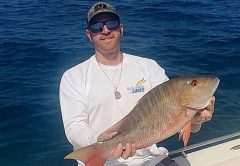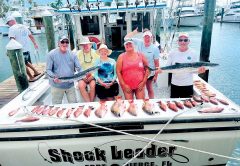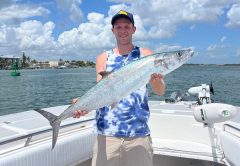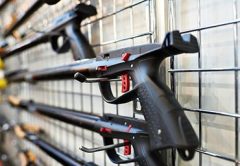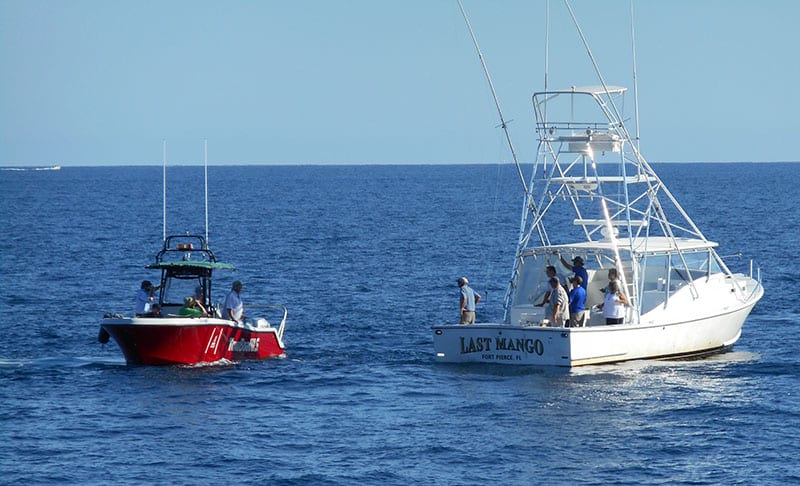
Over the last three summer deployment seasons, the St. Lucie County Artificial Reef Program (SLCARP) has deployed 4,000 tons of secondary concrete, 58 limestone special artificial reef modules, the 195-foot Dixie barge, the 65-foot Qualmann Marine barge and the Tug Kathleen. St. Lucie County currently has at least 3,000 tons of secondary concrete stockpiled at its Harbour Pointe Park staging area. This Spring, McCulley Marine Services will deploy 1,000 tons of this material on top of the Dixie barge. The remaining materials consist of concrete bridge piles, reinforced concrete pipe, reinforced concrete bridge slab, and a variety of other concrete materials that will create a diversity of habitats. The diversity of habitats leads to many species inhabiting St. Lucie County artificial reefs. This species richness is reinforced by the wide variety of fishes on the natural reefs and the location of the Treasure Coast as a transition between tropical and temperate fish fauna.
In March, the SLCARP will be applying for the 2018 Florida Fish and Wildlife Conservation Commission (FWC) artificial reef grant to deploy a 1,500-ton secondary concrete reef at depths of 100 to 110 feet. Artificial reefs in the 100 to 110-foot depth range have been noted to provide habitat for many adult sportfishes such as gag, scamp, and amberjack. In addition, monitoring of artificial reefs in the 90 to 100-foot depth range has detected juveniles from species such as snowy grouper and scamp. It is especially important to show that artificial reefs can provide habitat for larval fish to settle and grow to maturity. It is envisioned that eventually artificial reefs can be used by fisheries managers as another tool to help propagate fish stocks, thereby reducing fishing closed seasons.
The SLCARP hopes to deploy a 50-foot by 25-foot steel barge offered by Vogell Marine as a base for the 1,500-ton secondary concrete reef. Adding barges to its artificial reefs is another technique to increase habitat variability to artificial reefs. By deploying the barge first and then adding secondary concrete structures to the reef, the profile of the reef is increased. The reef protrudes into the water column, attracts schooling baitfish like blue runners and adds a pelagic component to the fish fauna inhabiting the reef (i.e. kingfish).
The SLCARP is partnering with the Coastal Conservation Association (CCA) to deploy a 250-ton secondary concrete reef offshore Broward County while deploying as many as 15 limestone special artificial modules offshore St. Lucie County. Five of the 58 modules already deployed offshore St. Lucie County have been memorial modules. These modules are an excellent way to memorialize loved one and also a great way to build habitat for local fish stocks. The modules add another layer of complexity to the SLCARP. The modules are eight feet tall and are deployed over open sand bottom, creating a moderate profile reef/sand bottom ecotone different from larger secondary concrete reefs or vessel reefs.
Realizing the economic advantages of an artificial reef program, local businesses and non-governmental organizations have started to become involved. In addition to the barge donation by Vogell Marine and planned partnership with the CCA, the 2016 deployment of artificial reef modules was attended by Last Mango Fishing Charters. The Last Mango is also participating in an FWC-sponsored study of St. Lucie County artificial reefs by Florida Atlantic University. Local businesses are also contributing to other aspects of the SLCARP.
For more information on the St. Lucie County Artificial Reef Program or deploying memorial artificial reef modules in St. Lucie County, or interested in writing a letter of support for the FWC artificial reef grant application, contact Jim Oppenborn, St. Lucie County Coastal Resources Coordinator at oppenbornj@stlucieco.org or (772) 462-1713.

